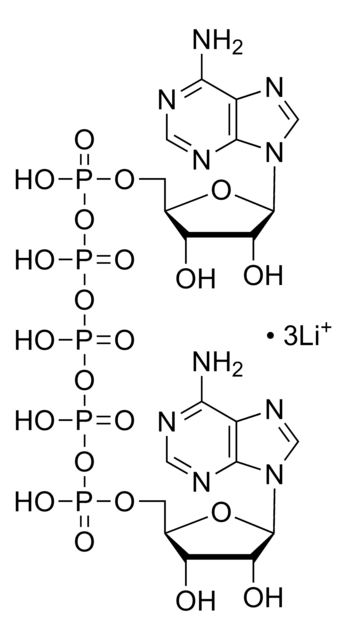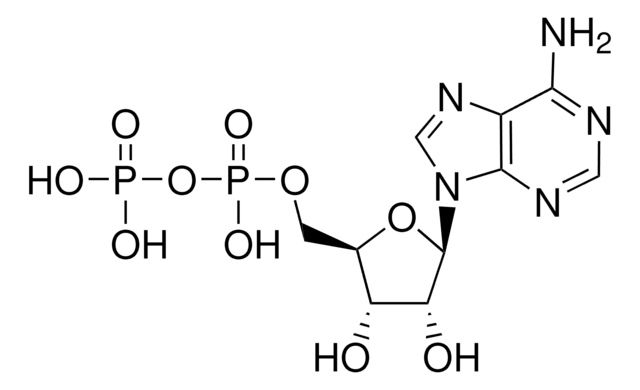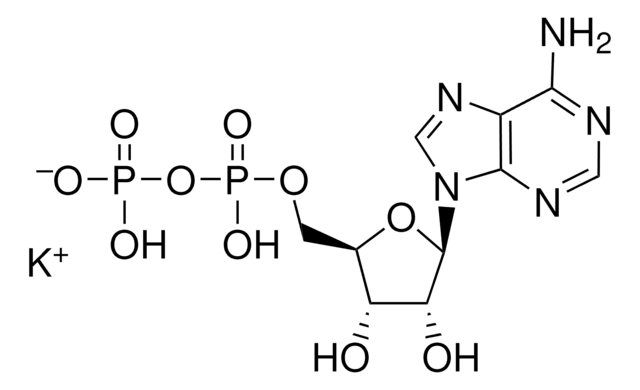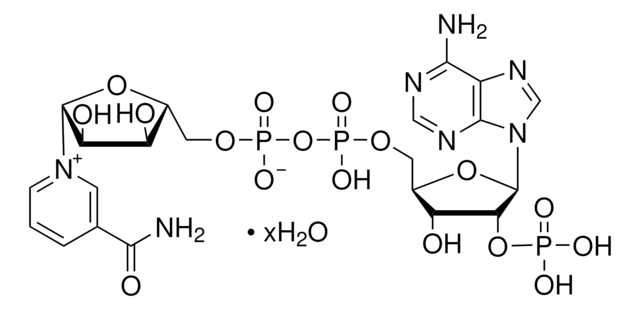D4022
P1,P5-Di(adenosine-5′) pentaphosphate pentasodium salt
≥95% (HPLC), powder
Sinônimo(s):
A(5′)P5(5′)A, Diadenosine pentaphosphate pentasodium salt
About This Item
Produtos recomendados
fonte biológica
synthetic (organic)
Ensaio
≥95% (HPLC)
forma
powder
peso molecular
~_1.0 kDa
cor
white to yellow-white
solubilidade
H2O: 50 mg/mL
temperatura de armazenamento
−20°C
cadeia de caracteres SMILES
[Na+].[Na+].[Na+].[Na+].[Na+].Nc1ncnc2n(cnc12)[C@@H]3O[C@H](COP([O-])(=O)OP([O-])(=O)OP([O-])(=O)OP([O-])(=O)OP([O-])(=O)OC[C@H]4O[C@H]([C@H](O)[C@@H]4O)n5cnc6c(N)ncnc56)[C@@H](O)[C@H]3O
InChI
1S/C20H29N10O22P5.5Na/c21-15-9-17(25-3-23-15)29(5-27-9)19-13(33)11(31)7(47-19)1-45-53(35,36)49-55(39,40)51-57(43,44)52-56(41,42)50-54(37,38)46-2-8-12(32)14(34)20(48-8)30-6-28-10-16(22)24-4-26-18(10)30;;;;;/h3-8,11-14,19-20,31-34H,1-2H2,(H,35,36)(H,37,38)(H,39,40)(H,41,42)(H,43,44)(H2,21,23,25)(H2,22,24,26);;;;;/q;5*+1/p-5/t7-,8-,11-,12-,13-,14-,19-,20-;;;;;/m1...../s1
chave InChI
NNMFUJJMJIYTSP-CSMIRWGRSA-I
Procurando produtos similares? Visita Guia de comparação de produtos
Descrição geral
Aplicação
- an adenylate kinase (AK) inhibitor in: sarcoma osteogenic (Saos-2) cells
- mitochondrial lysates during ATP synthesis
- tetramethylrhodamine methyl ester (TMRM) based membrane potential assay
- chromoplasts
Ações bioquímicas/fisiológicas
Código de classe de armazenamento
11 - Combustible Solids
Classe de risco de água (WGK)
WGK 3
Ponto de fulgor (°F)
Not applicable
Ponto de fulgor (°C)
Not applicable
Equipamento de proteção individual
Eyeshields, Gloves, type N95 (US)
Certificados de análise (COA)
Busque Certificados de análise (COA) digitando o Número do Lote do produto. Os números de lote e remessa podem ser encontrados no rótulo de um produto após a palavra “Lot” ou “Batch”.
Já possui este produto?
Encontre a documentação dos produtos que você adquiriu recentemente na biblioteca de documentos.
Os clientes também visualizaram
Nossa equipe de cientistas tem experiência em todas as áreas de pesquisa, incluindo Life Sciences, ciência de materiais, síntese química, cromatografia, química analítica e muitas outras.
Entre em contato com a assistência técnica












